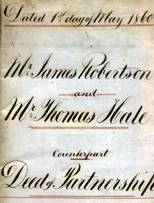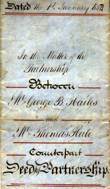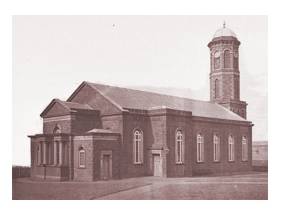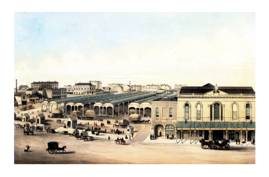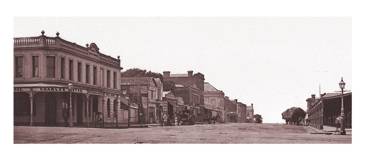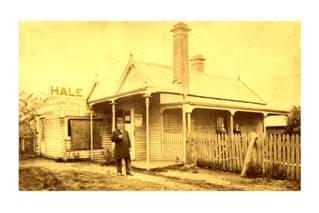THOMAS HALE
Thomas Hale was born (baptised?) on 21st September 1821 in St Peter Port on the Channel Island of Guernsey. His parents Joel Hale and Elizabeth Mitchell had married there on the 12th December 1820. According to the parish register entry for his marriage Joel Hale was born about 1790, the son of Joel Hale of Walcot Parish near the centre of Bath in Somerset.
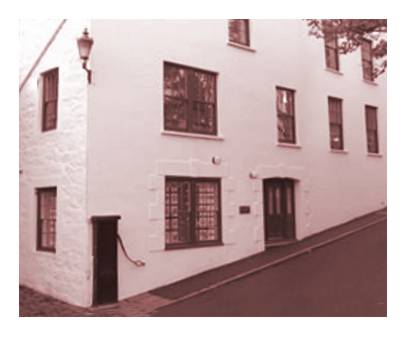 It is probable that Thomas spent at least the latter part of his early life living at the Cross Keys Inn in St Peter Port. It seems that the inn was located at what is now 8 Lefebvre Street but was replaced by an office building in about 1925 (see map). The photo at the right shows the building at 10 Lefebvre across the old Cross Keys Lane from number 8. I'm not sure of its age but it may give an idea of the inn's architectural style (or may not!).
It is probable that Thomas spent at least the latter part of his early life living at the Cross Keys Inn in St Peter Port. It seems that the inn was located at what is now 8 Lefebvre Street but was replaced by an office building in about 1925 (see map). The photo at the right shows the building at 10 Lefebvre across the old Cross Keys Lane from number 8. I'm not sure of its age but it may give an idea of the inn's architectural style (or may not!).
In 1841 Joel was described as a publican of Court Street, St Peter Port, and in 1851 he seems to be at the same address but is described as a second hand dealer. An obituary for Thomas written in 1884 states that he was "son of Mr Joel Hale, deceased, formerly occupant of the Cross Keys public house, situated in Lefebere Street, at present a lodging house owned by Mr J. Sauvage". In 1881 a Joseph Savage occupied a lodging house at number 8. It seems that sometime between 1851 and 1861 Court Street was renamed Lefebvre Street in honour of Captain (later Admiral) Nicholas Lefebvre. I haven't been able to confirm the name change but the evidence is strong. (The description of the census districts in 1851 and 1861 are pretty much identical but with Lefebvre replacing Court on the 1861 census. The people and houses suggest they are the same with the Lefebvre family in Court St in 1851 and Lefebvre in 1861. The Manor House and Cross Keys Lane between numbers 8 and 10 are off Court and Lefebvre respectively in 1851 and 1861. I can also find no sign of Lefebvre Street on any of the censuses earlier than 1861)
It is unclear when Thomas' father arrived in Guernsey but there is a clue in the age of another Joel Hale, sailmaker, recorded as living with the family on the 1841 census. He was born in St Peter Port and from his name it seems likely he was Thomas' brother but his age is given as being in the 30 to 34 range, far too old to be Elizabeth's son. Was this a second marriage with Thomas' father already in Guernsey prior to 1810 with his first wife or was the age recorded incorrectly or maybe Joel not Thomas' brother at all, a cousin maybe? Unfortunately I haven't been able to find this youngest Joel after 1841 but hopefully the Guernsey church records will hold the answer.
Thomas' mother Elizabeth Mitchell was born on 27th Jan 1799 in Portsea, Hampshire close by the Portsmouth naval facility at that time and for more than a decade a bustling port supporting the Royal Navy in the Napoleonic Wars. Her father William seems to have been a native of the Gosport / Portsea area and her mother, Jane Caws likely originated from the Isle of Wight where this name was common. There were apparently Caws involved in ship piloting operations in and out of Portsmouth harbour. The connection with the sea was also strong in the Hale family with three of Thomas' brothers described as mariners.
Although there is no evidence it is interesting to play with the idea of some family involvement in smuggling. During and after the blockade of Napoleon's Europe Guernsey was a primary stepping stone to England for contraband. The Hales, Mitchells and Caws seem almost too perfectly placed with a Guernsey publican and secondhand dealer, Isle of Wight channel boatmen, Portsea brokers and dealers and a small gang of seagoing sons. We know the connections between the Mitchells and Hales remained strong well into the mid 1800s with the 1851 census recording a swap of cousins seeing Lydia Mitchell with the Hales in St Peter Port and John Hale with the Mitchells in Portsea. Considering this it seems at least possible that Thomas learnt his trade as carpenter at the Portsmouth naval dockyards while staying with his mother's family in Portsea. Unfortunately by early June 1841, just before the census could provide us with some hint of his movements, he had left England via Plymouth and was sailing to Australia on the ship, Middlesex with his sister Jane both as "assisted" migrants. Thomas' "native place" was recorded as being Hampshire whilst that of Jane was Guernsey.
On the 30th September 1841 Thomas Hale having just turned 20 arrived in the Port Phillip colony . He was recorded as being a carpenter and both his sister and he declared they were able to read and write. On board with them was Mary Bishop (nee Hill), a widow born in Port Isaac, Cornwall. Her age on the voyage was recorded as 27 but parish records from Corwall suggest she may have been at least four years older. Three months after arriving Thomas and Mary were married.
The marriage is recorded as taking place at St James Church on the 28th December 1841. St James (pictured) was to become Melbourne's first Anglican cathedral which it remained until the completion of St Pauls. It was then moved block by block to its current location in King Street after 1891. Thomas and Mary were probably married in the earlier "pioneer" wooden church which in December 1841 would have been standing close by its almost completed stone replacement (above) on its 5 acre grounds bounded by William, Bourke and Collins streets (3). The witnesses were Jane Hale and a John and Elizabeth Roberts. Mary signed with her mark.
70 Stephen Street
The 1864 view above is from the north side of Bourke Street looking across the Haymarket (now occupied by the Southern Cross Hotel) to Stephen (later Exhibition) Street . On the far left can be seen a wooden shed with the number 70 clearly visible. All the evidence points to this being the main building of Hailes and Hale, timber merchants, who occupied this site from about 1850 until 1854. There are also some strong indications that Thomas and his family lived at this address for a number of years. The same building can be seen in the photo below ten years later.
In 1850 G B Hailes was recorded as the ratepayer and the property was described as consisting of a "counting house, a workshop, 2 sheds and a yard". It had an annual value of 40 pounds. By 1851 the ratepayer had changed to Hailes and Hale and the description to "Shop, Workshop, Timber Yard, Sawpits and Shed" and the annual value had increased to 60 pounds. By 1853 the description was the same but the annual value had more than quadrupled to 300 pounds. The only other building listed on the street between Bourke and Little Collins in 1850, 1851 and 1853 was a five room brick house to the south but by 1854 the block was starting to fill up. That year is the last in which a directory entry appears for Hailes and Hale and the 1854 rate book shows the ratepayer again as George Hailes with the land use described as "Coach factory and yard", the same as for the land next but one at number 66 where Heath and Co had set up business. It is likely that after the partnership finished that Hailes rented the yard at number 70 to this company. By the following year Hailes is no longer shown as the ratepayer although he seems to have retained ownership of a smaller piece of the land until at least 1864.
In 1851 Thomas Hale is listed in the Port Phillip Directory as being a carpenter living "off Little Collins Street East". The same directory has George Hailes possibly very close at 48 Stephen Street almost on the little Collins corner. The Electoral Roll was probably not updated after 1850 and for 1851 to 1854 shows Thomas Hale still at Little Collins Street. The Citizen Rolls for these years have him being rated for a "house" at 70 Stephens Street and in December 1853 the place of death of son John is given as "Stephen Street". All this points to Thomas and family moving about 1851 to some sort of dwelling attached to the Hailes and Hale timber yard and remaining there until early 1854.
The photograph above is the only one of Thomas Hale known to still exist. It dates from the early 1870s and was probably taken in Daylesford, possibly 3 Howe Street which was listed as his office in 1865. The two women are likely to be either his two daughters or a daughter and his second wife, Frances Moore.
